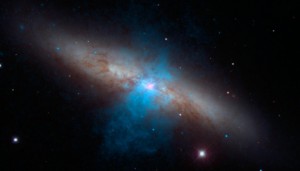Two studies suggest that ultraluminous X-ray sources are not all created by beefy black holes.
The surprisingly bright objects known as ultraluminous X-ray sources (ULXs) are not all alike, new research shows. ULXs spew out X-rays at luminosities millions of times the Sun’s total luminosity, and roughly a trillion times the Sun’s luminosity in X-rays. When they were first discovered three decades ago, astronomers thought they might be the glow from gas-gobbling intermediate-mass black holes. These theoretical objects have masses of hundreds to thousands of Suns and would fill the no-man’s land between stellar-mass black holes and supermassive black holes. Subsequent research has failed to conclusively settle the question.

NASA / JPL-Caltech / SAO / NOAO
But recent results show that there’s more than one way to make a ULX. A pair of papers published on October 9th in Nature reveal the inner workings of two ULXs, and demonstrate that neither is an intermediate-mass black hole.
The standard explanation for ULXs is that they result from black holes accreting matter from a companion star. As the matter is pulled into an accretion disk before falling into the black hole, it is heated to extreme temperatures and radiates X-rays.
But a theoretical constraint on how quickly a black hole can gobble up matter — known as the Eddington limit — puts a cap on how bright such objects can be. If the black hole tries to swallow too much matter at once, the outward pressure of radiation from that material pushes back on the matter falling in, cutting off the black hole’s meal. The radiation-gravity balance means that a black hole’s brightness has a limit.
The more massive the black hole, the brighter it can be. But ULXs are uncomfortably bright: to explain them, a stellar-mass black hole would need to reach or surpass its Eddington limit. That suggests these sources are intermediate-mass black holes. Among all ULXs, the sources M82 X-1 and ESO 243-49 HLX-1 are the two best candidates; evidence suggesting that M82 X-1 is a 400 solar-mass black hole recently appeared in the September 4th issue of Nature.
Another favored explanation for ULXs is that they are stellar-mass black holes that exceed the Eddington limit — and are therefore more luminous than expected — due to a “force-feeding” of the black hole that can occur under certain conditions.
Now, Christian Motch (University of Strasbourg, France) and a team of astronomers found evidence of a ULX doing just that. The ULX is located in the spiral galaxy NGC 7793, 12 million light-years from Earth. By observing variations in the light from the system, the team measured the orbital period of the black hole and its companion to 64 days and constrained the mass of the black hole to be less than 15 solar masses. This means that the black hole at the center of this ULX gobbles up matter at twice its Eddington limit, confirming the force-feeding picture.
But nature is prone to throw curveballs. Matteo Bachetti (University of Toulouse, France) and colleagues found that another ULX was not a black hole at all, but a pulsar — an explanation astronomers hadn’t anticipated. The team used NASA’s NuSTAR telescope to examine the signal from another ULX in the galaxy M82, also 12 million light-years away, and were surprised to see pulsations: the dead giveaway of a pulsar. The ULX is more than 10 times brighter than any accreting pulsar seen thus far.
Scientists had not expected pulsars to be an explanation for ULXs, because they would have to exceed their Eddington limits to an extreme degree. In this case, the Eddington limit is surpassed by a factor of 100 — an unprecedented amount, difficult to reconcile with theory.
“It’s going to send the theorists back to the drawing board to figure out how that object can actually be accreting at this high rate,” says Philip Kaaret (University of Iowa), who was not involved with the research.
It’s not yet clear how many ULXs can be explained by each of the three possibilities: pulsars, stellar-mass black holes, and intermediate-mass black holes. But if pulsars were a common culprit, they would likely have been found out already, says Richard Mushotzky (University of Maryland). “We’re now forced to realize that what previously had been one class of objects is at least three classes of objects, and maybe more,” he says. “Nature is a lot more rich and complex than even our imagination can grasp.”
Scientists now may want to take a closer look at some ULXs they’ve assumed were run-of-the-mill. One thing’s for sure: Occam’s razor does not apply.
References:
C. Motch et al. "A mass of less than 15 solar masses for the black hole in an ultraluminous X-ray source." Nature. October 9, 2014.
M. Bachetti et al. "An ultraluminous X-ray source powered by an accreting neutron star." Nature. October 9, 2014.
Download our eBook on black holes when you register for S&T's website — both registration and the eBook are free! (If you're already registered, then just sign in and download away!)
 0
0









Comments
You must be logged in to post a comment.